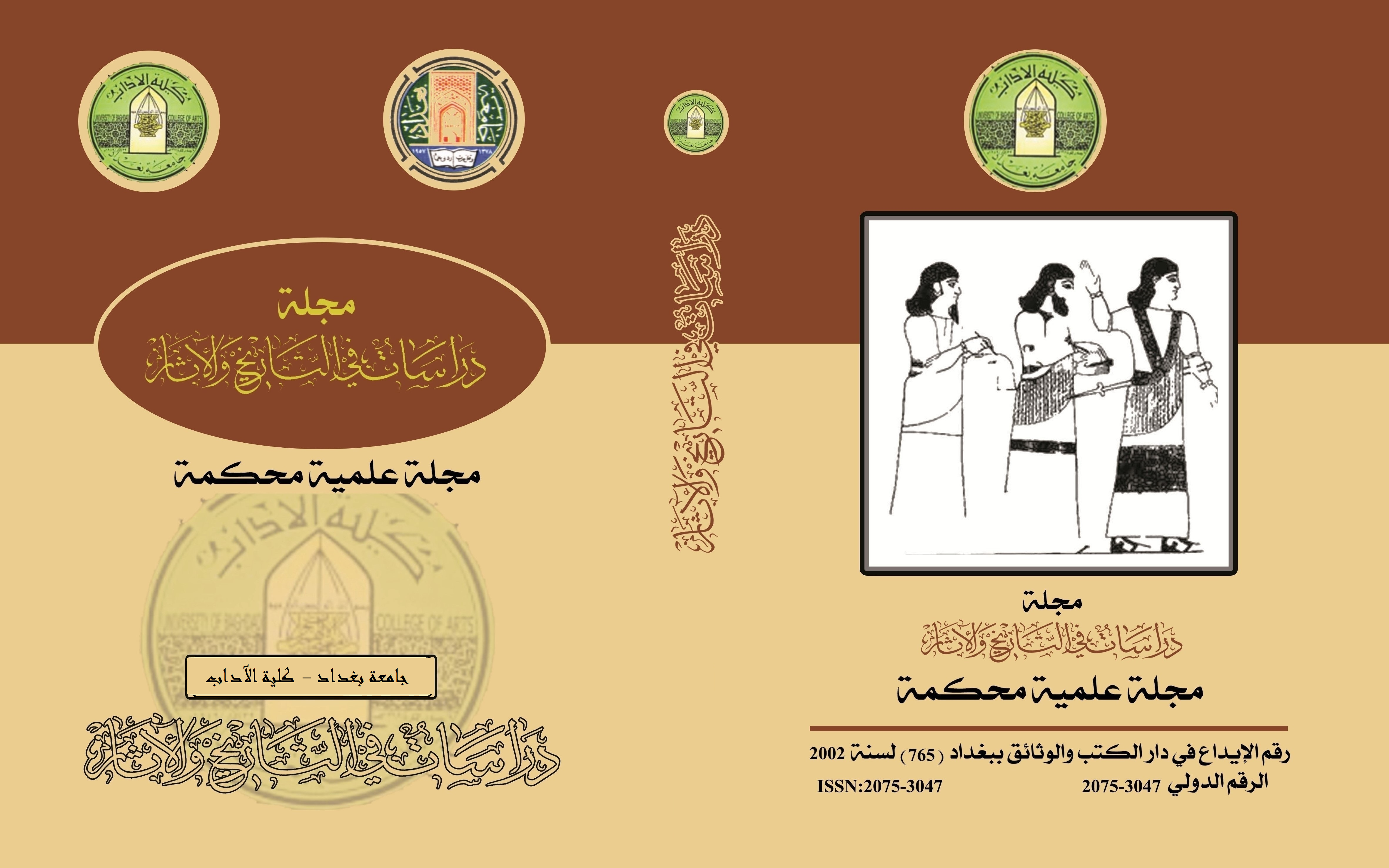The Apposition in the Akkadian Sentence
Keywords:
البدل, الجملة الاكديةAbstract
The importance of grammatical studies of the Akkadian language lies in the fact that it represents a cultural aspect of that language , and evidence of its authenticity and controls governing the its use.The importance of grammatical studies is not limited to the performance function of the language, but it is noted that grammatical studies have their literary importance . Hence the idea came to study an important semantic element of the Akkadian sentence, namely the substitute, which appeared clearly in the lines of the Akkadian cuneiform texts in their various dialects, whether Babylonian or Assyrian, which indicates the advanced and developed linguistic stages that the Akkadian language passed through or reached more than 4000 years ago. Perhaps the researcher in ancient languages and their texts and what they carry of value and precious human legacy will not find what he is looking for anywhere as much as he will find it in the Akkadian texts, which were truly the best ambassador for human languages in general and Semitic languages in particular throughout the ages and eras until the beginning of the Christian era . The substitute in the Akkadian language is known as the noun linked to another noun, the purpose of which is to increase clarification, or the noun linked to the predicate or dependent adjectives and is in the same state as the noun being substituted from, and is usually placed, i.e. the substitute, after the substituted from. The substitute is thus a noun or nominal phrase that describes another noun or nominal phrase in the manner of an attributive adjective, in which the descriptive noun usually follows the described noun and is in the same state . The substitute is a dependent that comes after a noun before it , clarifying it and explaining what is meant by it, and the substituted from comes before it, paving the way for it. It is called a substitute because it can replace the substituted from and dispense with it.
References
- ابن منظور ، ابي الفضل جمال الدين محمد بن مكرم ، لسان العرب ، بيروت ، د.ت ، ( مادة بدل).
- مجالس ثعلب ، أبو العباس أحمد بن یحیى ، شرح وتحقیق عبـد الســلام ھـــارون ، دار المعارف بمصر / ١٩٠٦م / ١٣٧٥ھـ/ ط٢ .ص .
- سمير ، محمد ، معجـم المصطلحات النحوية و الصرفية ، د : ط١ ، بیروت ، ١٩٨٥م ، ص 20.
- سمير ، محمد ، مصدر سابق ، ص 21.
- شرح بن عقیل ، بھاء الدین عبد الله بن عقیل ، ط٢٠ / ١٩٨ م/ ١٤٠٠ ھـ ، دار التراث ، القاھرة ، ص 247 ؛ عبد المسیــح ، جورج متــرى ، معجم قواعد اللغة العربیة في جداول ولوحات ، ط١ ، مكتبة لبنان / ١٩٨١ م ، ص 222 .
- زیاد ، سعد ، موسوعة النحو والأعراب ، دار الریاض للطباعة والنشر، ط ١،١٩٩٣م ، ص 29.
- Lipinski , E., Semitic Languages Outline of a Comparative Grammar (Orientalia Lovaniensia Analecta) , Leuven , 1997, p. 496 .
- الغلاييني ، الشيخ مصطفى ، جامعة الدروس العربية ، بعناية ، د. كوكب ديب دياب ، ط1 ، طرابلس – لبنان ، 2004، ص ، 606 .
- عبد ، يسرى عباس ، البدل واحكامه في اللغة ( دراسة سامية مقارنة ) مجلة كلية الاداب / ملحق العدد 123 ، بغداد ، 2020 ، ص 534 .
- Lipinski , E., Semitic Languages Outline of a Comparative Grammar (Orientalia Lovaniensia Analecta) , Leuven , 1997, p. 496 .
- GAG , $ . 134 : 1 , p. 233 .
- GAAK , p. 91 .
- Kouwenberg , N.J.C., A Grammar of Old Assyrian ( GOASS ) , Leiden: Brill, 2017, p.242 .
- Frayn.D. Old Babylonian period ,toronto , 1990, (RIME4) .ḫa-am-mu-ra-pí . no.2 : 6-8 , p. 337 .
- Huehnergard , J ., On verbless clauses in Akkadian , ZA ,Band , 76 / II,1986 ., p . 230 .
- ومن امثلته : آمنت بما جاء به الرسول (محمد) ، فكلمة (محمد) في هذا المثال هي البدل ، اما المبدل منه فهو( الرسول) ويجوز حذف المبدل منه ،فنقول: آمنت بما جاء به محمد . أي نذكر فقط البدل وهو (محمد) ، وكذلك : النبي محمد خاتم المرسلين . (محمد) هو البدل ، والمبدل منه (النبي) ويجوز حذفه فتكون الجملة: محمد خاتم المرسلين ، وفي قوله تعالى : { اهْدِنَا الصِّرَاطَ الْمُسْتَقِيمَ (6) صِرَاطَ الَّذِينَ أَنْعَمْتَ عَلَيْهِمْ غَيْرِ الْمَغْضُوبِ عَلَيْهِمْ وَلَا الضَّالِّينَ (7) } الفاتحة : 6-7 ، فالصراط المستقيم وصراط المنعم عليهم ، متطابقان في المعنى لانهما كليهما يدلان على معنى واحدٍ ، للمزيد ، ينظر ، الغلاييني ، الشيخ مصطفى ، مصدر سابق ، 606 .
- Richardson , M.E.J., Richardson , M.E.J , ., Hammurabi’s Laws Text , Translation and Glossary , New York , 2004., p. 128 .
- Novotny , J , and Jeffers , J .,The Royal Inscriptions of Ashurbanipal (668–631 BC), Aššur-etel-ilāni (630–627 BC), and Sîn-šarra-iškun (626–612 BC), Kings of Assyria, Part 1, Indiana EISENBRAUNS 2018 , Ashurbanipal . Col.X : 1-3 , p.260 .
- CAD , A : I , p. 137 : b .
- Frayn.D. Old Babylonian period ,toronto , 1990, (RIME4) . Iaḫdun-LTm E4.6.8.2. no.2: 41-7, p.606 .
- وهو كذلك في اللغة العربية أي الذي يكون فيه البدل جزءاً حقيقياً من المبدل منه وهو بدل الجزء من الشيء كله ، مثل : صَرَفْتُ المالَ رُبْعَهُ أو نِصْفَهُ ، وجاءت القبيلة رُبُعها أو نصفُها فكلمة (ربع) الواردة في الجملتين السابقتين هي جزء من كل من المال في الاولى وهي منصوبة على أنها بدل بعض من كل وكذلك ( نصْفَهُ ) ، و هي جزء من كل من القبيلة في الثانية وهي مرفوعة على أنها بدل بعض من كل وكذلك ( نصْفُها )، للمزيد ، ينظر ، الغلاييني ، الشيخ مصطفى ، مصدر سابق ، 606 .
- Knudtzon ,J. A., Die El-Amarna Tafeln (= VAB 2) EA , no.138 : 71-3, Leipzig , 1915 .
- التجرية : هي احدى اللهجات الحبشية التي يتحدث بها نحو 300 ألف شخص من أشباه البدو في اريتريا وهي قوية الشبه بالجعزية إلا أن معظم الباحثين يرون أنها غير متفرعة عنها بل لغة أخرى قديمة لم يصل إلينا شيء من آثارها وعلى الرغم من عدم استخدامها في الكتابة فهي من اللهجات القوية المنتشرة إلى الشمال من منطقة اللهجة التجرينية وقد استعملت لغة تخاطب في هذه المناطق إذ تغلبت على السنة كثير من أهل البلاد المجاورة لها فضلاً عن استعمالها لغة ثانية لدى بعض العشائر الحامية والسودانية الباقية على ألسنتها القديمة . ويتألف معظم المتكلمين بهذه اللغة من القبائل الإسلامية التي تقطن المنطقة الساحلية من مصوغ إلى سواكن وجزر هلك ولعل اعتناق المتكلمين بها للإسلام كان من أهم العوامل التي ساعدتها على مقاومة الأمهرية المسيحية فلم تتمكن من التغلب عليها ، كما أن اعتناق المتكلمين بهذه اللهجة للدين الإسلامي قد ترك فيها كثيراً من وجوه التأثر باللغة العربية ، للمزيد ينظر :
- علي ، محمد محارب ، مقدمة في اللغات السامية ، محاضرات غير منشورة ، الموصل ، 2023 ، ص 62 .
- Lipinski , E., Semitic Languages Outline of a Comparative Grammar (Orientalia Lovaniensia Analecta) , Leuven , 1997, p. 496 .
- GAG , $ . 134 : b , p. 233 .
- GAAK , p. 91 .
- GAG , $ . 134 : b , p. 233 .
- GAAK , p. 92 .
- للمزيد بخصوص الاسماء الشخصية في اللغة الاكدية ، ينظر :
- Stamm,J.J.,Die Akkadischen Namen Gebung.,Lipzig,1968 ;
- بدر ، خالد علي خطاب ، الاسماء الشخصية البابلية القديمة-دلالة ومعجم ، اطروحة دكتوراه غير منشورة ، الموصل ، 2023 .
- Henry , M . J. , The Syntax of reduced nominals in akkadian , PhD Thesis. SOAS,University of London , 2013 , p. 35 ; AbB , 8 , no . 11 : 5-6 .
- للمزيد بخصوص اسم فاعل في اللغة الاكدية ، ينظر :
- أمين ، أمين عبد النافع ، اسم الفاعل في اللغات في اللغات العاربة بين الاسمية والفعلية : دراسة مقارنة في ضوء الفصحى واللغات العاربة ، آداب الرافدين ، ع 56 ، 2010 ؛ حمزة ، سرى عمار ، اسم الفاعل في اللغة الاكدية – دراسة صرفية نحوية ، رسالة ماجستير غير منشورة ، الموصل ، 2023 .
- سليمان ، عامر ، نماذج من الكتابة المسمارية ، مصدر سابق ، ص 96 .
- برجشتراسر ، التطور النحوي للغة العربية ، ترجمة : د. رمضان عبد التواب ، القاهرة ، 1982 ، ص 150.
- إبراهيم ، كروان عامر سليمان ، الاسم في اللغة الاكدية دراسة مقارنة ، رسالة ماجستير غير منشورة ، الموصل ، 2001 ، ص 62.
- حنون ، نائل ، شريعة حمورابي ، ج 5 ، دمشق ، 2005 ، ص 72 .
- Richardson , M.E.J., Richardson , M.E.J , op , cit., p. 124 .
- CAD , A : I , p. 194 : a .
- للمزيد بخصوص الضمائر المنفصلة في اللغة الاكدية ، ينظر :
- المزوري ، رونق جندي صبري ، الضمائر الشخصية في اللغة الاكدية – دراسة مقارنة - ، رسالة ماجستير غير منشورة ، الموصل ، 2006 ؛ رشيد ، فوزي ، قواعد اللغة الاكدية ، دمشق ،2009 ، ص 19.
- GAAK , p. 92 .
- GAAK , p. 272 .
- GAG , $ . 134 : b , p. 233 .
- Michael P. Streck , Akkadisch , Sprachen des Alten Orients , Hardcover – 1 Sept. 2007 , p.72 ; Michael P. Streck ,Altbabylonische Grammatik mit Grundwortschatz, Übungen und Chrestomathie , Stand 2006 Leipzig , p. 62 .
- GAAK , p. 91 .
- يُعرف اسم الإشارة في اللغة العربية بأنه اسم يُعيَّنُ مدلوله تعيينًا مقرونًا بإشارة حسيّة، كأن يرى الرجل طيرًا فيشير إليه ويقول: "ذا" رشيق، ويعدّ اسم الإشارة من الاسماء المبنية إذ تتكون أسماء الإشارة من ثلاثة أقسام وهي: ما يشار به إلى المفرد، وما يشار به إلى المثنی، وما يُشار به إلى الجمع، وتنقسم هذه الثلاثة أقسام إلى مذكر ومؤنث، نقول: (هذا) للقريب وهو مكون من ها التنبيه وذا وهو اسم الإشارة الأصلي، وهذه للقريبة ، للمزيد ينظر :
- حسن، عباس ، النحو الوافي، ص321 -324 ؛ مغالسة ، محمود حسني ، النحو الشافي، ص 106.
- سليمان ، عامر ، اللغة الأكدية ( البابلية – الآشورية ) ، طبعة مزيدة ومنقحة ، الموصل ، 2005 ، ص 193 .
- رشيد ، فوزي ، مصدر سابق ، ص 22 .
- CAD , A : I , p. 137 : a .
- GAAK , p. 41 .
- Kouwenberg , n. J. C ., The Akkadian Verb and Its Semitic Background , ( AKKVSB ) .,Winona Lake, Indiana EisenbRauns , 2010 , p.197 ; AbB ,6.no.63:5- 6.
- GAAK , p. 41 .
- AbB , 8 . no.12 : 15-17.
- Eran , C , the Modal system of old Babylonian , Winona Lake, Indiana 2005 , p.195 .
- تستخدم اللغات السامية أيضًا عددمن الأسماء كسوابق صلة أو تعرف بالسوابق النسبية، بغض النظر عن معناها الأصلي. وأشهرها هي الأداة ašar للاسم الآشوري البابلي ašru ، "مكان" ('atr- أثر )، والاسم العبري والموآبي 'âšer. في البداية، كان هذا الاسم يتبعه ببساطة جملة صلة أو جملة نسبية غير مترابطة : على سبيل المثال في الآشورية و البابلية :imtaši ašar iwwaldu" لقد نسي (المكان) الذي ولد فيه " ثم تم استخدامه في مقابل اسم آخر يدل على مكان،كما في البابلية:"حقله ، (المكان) الذي أعطيته" eqelšu... ašar tattadnu
وفي العبرية: " البيت (المكان) الذي بنيته" âšer bāriītī' habbayit ، و بما أن معنى "آشر âšer " قد نُسي في العبرية ، فقد بدأ استخدام الكلمة قريبًا مع أي عنصر مؤهل، على سبيل المثال: qob 'âšer bǝḥartīkā Ya'a "يعقوب، (المكان) الذي اخترته". وفي الآشورية الحديثة، يُستخدم أيضًا الاسم bēt، "البيت"، بهذه الطريقة، مثل "(البيت) أينما يأمر الملك، يجب أن يذهبوا" bēt šarru iqbūni lillikū ؛
"اكتب (البيت) حيث هو" šupru bēt sūtūni ، وفي العديد من اللغات السامية، يمكن أيضًا استخدام ضمير الاستفهام والضمير المنفصل كسابقة صلة نسبية . للمزيد ، ينظر :
- Lipinski , E., Semitic Languages Outline of a Comparative Grammar (Orientalia Lovaniensia Analecta) , Leuven , 1997, p.327 .
- وكذلك في اللغة العربية فقد يأتي الاسم الموصول بدلاً كما في إعراب قوله تعالى : { قُلْ مَن ذَا الَّذِي يَعْصِمُكُم مِّنَ اللَّهِ } الأحزاب : 17 . إذ يعرب الذي اسم موصل مبني على السكون في محل رفع بدل .
- GAAK , p. 11 .
- GAAK , p. 185 .
- GAAK , p. 185 .
- GAAK , p. 186 .
- GAAK , p. 363 .
- Buccellati ,G.,A Structural Grammar of Babylonian (SGB), Wiesbaden ,1996 , p.458.
- AbB , 13 , no.44 : 10 .
- AbB , 13 , no.60 : 2 .
- GAG , $ . 134 : g , p. 234 .
- Kouwenberg , N.J.C., ( GOASS ) , p.243 .
- Frayn.D., (RIME4) . Samsu-iluna E4.3.7.10. no. 7 : 104 , p. 387 .
- Frayn.D., (RIME4) . Iaḫdun-Lim E4.6.8.1.2. no.2 : 1-4 , p. 605 .
- Ungnad , A ., Akkadian Grammar ( AKKG ) , 5th Ed,translated by Harry , A., Hoffner , Jr .1992 , p. 111 .
- Ungnad , A ., ( AKKG ), p. 111 .
- Ungnad , A ., ( AKKG ) , p. 111 .
- Buccellati ,G.,A , (SGB), p.459.
- ARM , 1,no. 36: 28-29.
- AbB, 2 , no. 23: 5'.
- Buccellati ,G.,A , (SGB), p.459.
- Ungnad , A ., Akkadian Grammar ( AKKG ) , 5th Ed,translated by Harry , A., Hoffner , Jr .1992 , p. 111 .
- AKKG , p. 111 .
- AKKG , p. 111 .
- Mercer,S.A.B.,Assyrian Grammar , London ,1921 , p. 48.
- GAAK , p. 91 .
Downloads
Published
Issue
Section
License

This work is licensed under a Creative Commons Attribution 4.0 International License.
Copyright and Licensing:
For all articles published in Journal of Studies in History and Archeology, copyright is retained by the authors. Articles are licensed under an open access Creative Commons CC BY 4.0 license, meaning that anyone may download and read the paper for free. In addition, the article may be reused and quoted provided that the original published version is cited. These conditions allow for maximum use and exposure of the work.
Reproducing Published Material from other Publishers: It is absolutely essential that authors obtain permission to reproduce any published material (figures, schemes, tables or any extract of a text) which does not fall into the public domain, or for which they do not hold the copyright. Permission should be requested by the authors from the copyrightholder (usually the Publisher, please refer to the imprint of the individual publications to identify the copyrightholder).
Permission is required for: Your own works published by other Publishers and for which you did not retain copyright.
Substantial extracts from anyones' works or a series of works.
Use of Tables, Graphs, Charts, Schemes and Artworks if they are unaltered or slightly modified.
Photographs for which you do not hold copyright.
Permission is not required for: Reconstruction of your own table with data already published elsewhere. Please notice that in this case you must cite the source of the data in the form of either "Data from..." or "Adapted from...".
Reasonably short quotes are considered fair use and therefore do not require permission.
Graphs, Charts, Schemes and Artworks that are completely redrawn by the authors and significantly changed beyond recognition do not require permission.
Obtaining Permission
In order to avoid unnecessary delays in the publication process, you should start obtaining permissions as early as possible. If in any doubt about the copyright, apply for permission. Al-Adab Journal cannot publish material from other publications without permission.
The copyright holder may give you instructions on the form of acknowledgement to be followed; otherwise follow the style: "Reproduced with permission from [author], [book/journal title]; published by [publisher], [year].' at the end of the caption of the Table, Figure or Scheme.



















